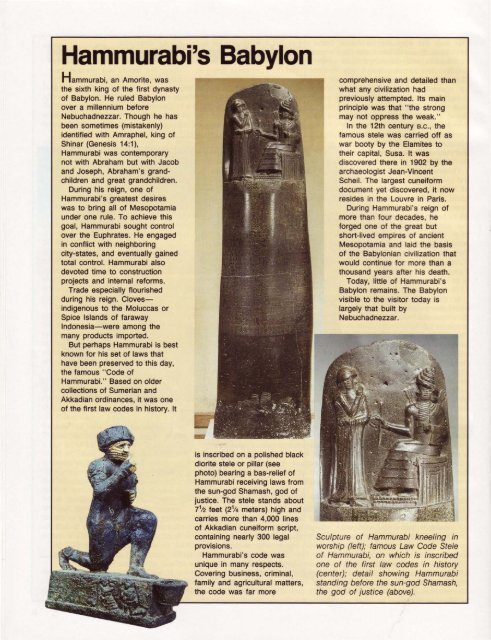It was the opportunity for afresh start. Some heeded, but thedesire to be self-reliant <strong>and</strong> independentwas a strong temptation.The old attitudes quickly sprungup again as men <strong>and</strong> womenthought they knew better than<strong>God</strong>. A few score years after theFlood a group <strong>of</strong> travelers w <strong>and</strong>eredinto Mesopotamia. As theyjourneyed " they found aplain in the l<strong>and</strong> <strong>of</strong> Shinar,<strong>and</strong> they dwelt there" (Genesis11 :2).They needed a base, a centralrallying point. The plain<strong>of</strong> Shinar seemed like anideal location. There theyfou nd resources <strong>and</strong> materialsto build a substantial city.But it wouldn't be just anycity. " They had brick forstone , <strong>and</strong> the had asphaltfor mortar. And ther aid ,'Come , let us build our elvea city, <strong>and</strong> a tower who e tOpis in the heavens'" (Genesi11 :3-4) .According to the Jew ish histOrianJosephus, the leader <strong>of</strong>these people was Nimrod, agr<strong>and</strong>son <strong>of</strong> Noah's son Ham.The Bible tells us that hegained the reputation for beinga " mighty hunter beforethe Lord" (Genesis 10:9) , anexpression that implies oppositionto <strong>God</strong>.There have been manyartist's impressions <strong>of</strong> whatthe Tower <strong>of</strong> Babel may havelooked like. Most are fanciful,some ridiculous. The tower wasalmost certainly a far less ambitiousbuilding. The plain <strong>of</strong> Shinaris generally flat, <strong>and</strong> even today abuilding a hundred or so feet highcan be seen for miles around. Atower that " reached to heaven"would not have had to be anyhigher to be a l<strong>and</strong>mark in thisregion. The attitude <strong>of</strong> thebuilders was " let us make a namefor ourselves, lest we be scatteredabroad over the face <strong>of</strong> the wholeearth" ( Genesis 11 :4, italicsadded).This was not w hat <strong>God</strong> had intended. The earth had to be repopulated,<strong>and</strong> the human racediversified . <strong>God</strong> allowed thebuilders to continue to w ork onthe tower for a while (Sumeriantradition has it for two years), buteventually he decided to intervene." But the Lord came down tosee the city <strong>and</strong> the tower whichthe sons <strong>of</strong> men had built" (Genesis11 :5).The little, baked brick tower,protruding impudently out <strong>of</strong> theplain posed no threat to <strong>God</strong>, butArtists' conceptions <strong>of</strong> biblicalTower <strong>of</strong> Babel, early focus <strong>of</strong>mankind's defiance <strong>of</strong> <strong>God</strong>.it was a symbol <strong>of</strong> defiance <strong>and</strong> anexpression <strong>of</strong> the self-confident,independent attitude that had gottenAdam <strong>and</strong> Eve <strong>and</strong> their descendantsin trouble. <strong>God</strong> couldnot allow it to continue unchecked.The Tongues Are ConfusedThe Bible tells us that at thistime mankind shared a commonlanguage (Genesis 11 : 1) . Otherlanguages existed before theFlood, but it is quite logical thatthe first few generations <strong>of</strong> thedescendants <strong>of</strong> Noah would haveshared a common family tongue.It should have been a great advantage,but this fledgling civilizationwas clearly developing in thewrong direction.So as <strong>God</strong> reviewed the progressat Babel, he knew what had to bedone. He would not prevent humansfrom following their chosencourse, but he would slow themdown.Genesis tells us what happened."And the Lord said, 'Indeed thepeople are one <strong>and</strong> they all haveone language, <strong>and</strong> this is whatthey begin to do; now nothingthat they propose to do will bewithheld from them. Come, let Usgo down <strong>and</strong> there confuse theirlanguage, that they may not underst<strong>and</strong>one another's speech' "(Genesis 11 :6-7) .The builders were unable tocommunicate clearly with eachother, <strong>and</strong> so the building <strong>of</strong> theTower <strong>of</strong> Babel came to a halt.Families went their separate ways,to be scattered over the face <strong>of</strong>the earth <strong>and</strong> eventually to becometribes <strong>and</strong> nations.It was the first time that <strong>God</strong>intervened in the development <strong>of</strong>a "<strong>Babylon</strong>," but it would not bethe last.5
Hammurabi's <strong>Babylon</strong>Hammurabi, an Amorite, wasthe sixth king <strong>of</strong> the first dynasty<strong>of</strong> <strong>Babylon</strong>. He ruled <strong>Babylon</strong>over a millennium beforeNebuchadnezzar. Though he hasbeen sometimes (mistakenly)identified with Amraphel, king <strong>of</strong>Shinar (Genesis 14:1),Hammurabi was contemporarynot with Abraham but with Jacob<strong>and</strong> Joseph, Abraham's gr<strong>and</strong>children<strong>and</strong> great gr<strong>and</strong>children.During his reign, one <strong>of</strong>Hammurabi's greatest desireswas to bring all <strong>of</strong> Mesopotamiaunder one rule. To achieve thisgoal, Hammurabi sought controlover the Euphrates. He engagedin conflict with neighboringCity-states, <strong>and</strong> eventually gainedtotal control. Hammurabi alsodevoted time to constructionprojects <strong>and</strong> internal reforms.Trade especially flourishedduring his reign. Clovesindigenousto the Moluccas orSpice Isl<strong>and</strong>s <strong>of</strong> farawayIndonesia-were among themany products imported.But perhaps Hammurabi is bestknown for his set <strong>of</strong> laws thathave been preserved to this day,the famous "Code <strong>of</strong>Hammurabi." Based on oldercollections <strong>of</strong> Sumerian <strong>and</strong>Akkadian ordinances, it was one<strong>of</strong> the first law codes in history. Itcomprehensive <strong>and</strong> detailed thanwhat any civilization hadpreviously attempted. Its mainprinciple was that "the strongmay not oppress the weak."In the 12th century B.C., thefamous stele was carried <strong>of</strong>f aswar booty by the Elamites totheir capital, Susa. It wasdiscovered there in 1902 by thearchaeologist Jean-VincentScheil. The largest cuneiformdocument yet discovered, it nowresides in the Louvre in Paris.During Hammurabi's reign <strong>of</strong>more than four decades, heforged one <strong>of</strong> the great butshort-lived empires <strong>of</strong> ancientMesopotamia <strong>and</strong> laid the basis<strong>of</strong> the <strong>Babylon</strong>ian civilization thatwould continue for more than athous<strong>and</strong> years after his death.Today, little <strong>of</strong> Hammurabi's<strong>Babylon</strong> remains. The <strong>Babylon</strong>visible to the visitor today islargely that built byNebuchadnezzar.is inscribed on a polished blackdiorite stele or pillar (seephoto) bearing a bas-relief <strong>of</strong>Hammurabi receiving laws fromthe sun-god Shamash, god <strong>of</strong>justice. The stele st<strong>and</strong>s about7% feet (2% meters) high <strong>and</strong>carries more than 4,000 lines<strong>of</strong> Akkadian cuneiform script,containing nearly 300 legalprovisions.Hammurabi's code wasunique in many respects.Covering business, criminal,family <strong>and</strong> agricultural matters,the code was far moreSculpture <strong>of</strong> Hammurabi kneeling inworship (left); famous Law Code Stele<strong>of</strong> Hammurabi, on which is inscribedone <strong>of</strong> the first law codes in history(center); detail showing Hammurabist<strong>and</strong>ing before the sun-god Shamash,the god <strong>of</strong> justice (above).
















